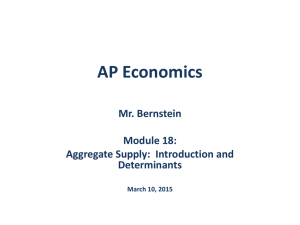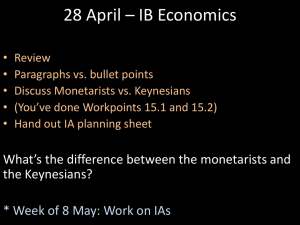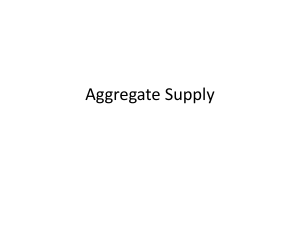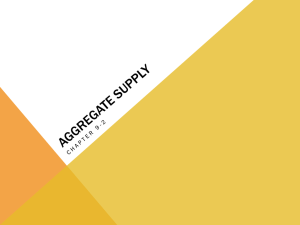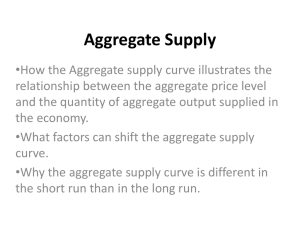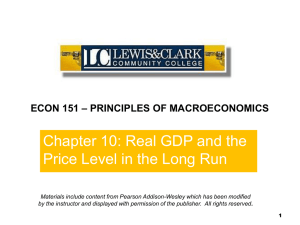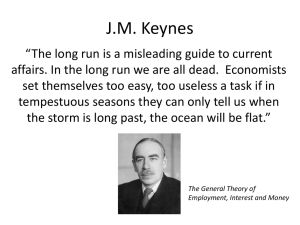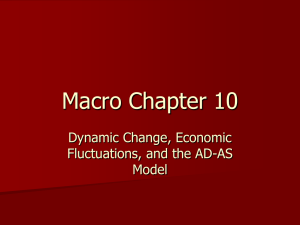Aggregate Supply: SRAS & LRAS Curves Explained
advertisement
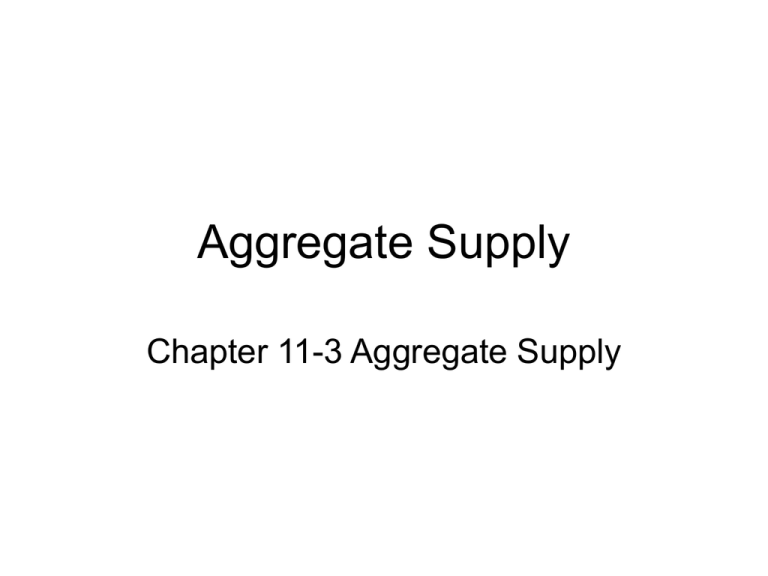
Aggregate Supply Chapter 11-3 Aggregate Supply Aggregate Supply • The aggregate supply curve shows the relationship between the aggregate price level and the quantity of aggregate output. Aggregate Supply Curve • Aggregate Supply is the amount of real GDP that will be made available by sellers at various price levels. • Aggregate Supply looks different in the Long Run and the Short Run: – In the Long Run, classical economists assume the economy operates at full employment (maximum output), independent of the price level. – In the Short Run, businesses will increase supply if the price level increases. Positive Relationship • There is a positive relationship in the short run between price level and the quantity of aggregate output supplied. The SAS is positively sloped because: • Auction markets – Prices are determined by demand and supply – prices profits quantity supplied • Posted-price markets – Prices are set by producers and don’t often change – Firms respond to changes in demand by adjusting output instead of prices Sticky Nominal Wages • The short-run aggregate supply curve is upward-sloping because nominal wages are sticky in the short run: – a higher aggregate price level leads to higher profits and increased aggregate output in the short run. • The nominal wage is the dollar amount of the wage paid. The Short-Run Aggregate Supply Curve Movement Vs. Shift • Movements are caused by change in Aggregate Price Levels • Shift in SRAS is caused by: Shift in SRAS • Changes in – commodity prices, – nominal wages, and – productivity • lead to changes in producers’ profits and shift the short-run aggregate supply curve Textbook lists 3 shift factors Price level SRAS1 1. Changes in Commodity prices 2. Change in Nominal Wages 3. Changes in productivity SRAS0 Real output The SRAS shifts upward for 5 reasons (outside the text) SRAS1 1. Increases in input prices Price level 2. Expectations of higher future inflation 3. Increases in sales and excise taxes SRAS0 4. Decreases in productivity 5. Increase in import prices Real output LRAS • The long-run aggregate supply curve shows the relationship between the aggregate price level and the quantity of aggregate output supplied that would exist if all prices, including nominal wages, were fully flexible A Range for Potential Output and the LAS Curve • The position of the long-run aggregate supply curve is determined by potential output. • Potential output – the amount of goods and services an economy can produce when both labor and capital are fully employed. Long-Run Aggregate Supply Curve Actual and Potential Output Economic Growth Shifts the LRAS Curve Rightward LAS LAS1 • The LAS curve shows the longrun relationship between output and the price level. • The position of the LAS curve Price Level depends on potential output – the amount of goods and services an economy can produce when both capital and labor are fully employed. • The LAS is vertical because potential output is unaffected by the price level. • Economic Potential output Real output growth shifts the LRAS to the right. From the Short Run to the Long Run Leftward Shift of the Short-run Aggregate Supply Curve From the Short Run to the Long Run Rightward Shift of the Short-run Aggregate Supply Curve LAS Curve LAS • Estimating potential output is inexact, so it is assumed to be the middle of a range bounded by a high level of potential output and a low level of potential output. C • The relationship between Price Level B A potential and actual output – where the economy is on SAS – determines shifts in SAS. SAS • When resources are over-utilized Underutilized resources (point C), factor prices may be bid up and the SAS shifts up. Overutilized resources • When resources are under-utilized Lowlevel potential output High-level potential output Real output (point A), factor prices may decrease and SAS shifts down. • When LAS = SAS (point B), there is no pressure for prices to rise or fall. The Following Slides are from your textbook. Long-Run Aggregate Supply Curve • LRAS is vertical line at full employment level of GDP (regardless of price level). Real GDP = $6 trillion at every point on LRAS. Long-Run Macroeconomic Equilibrium LR equilibrium of $6 trillion in real GDP and price level of 100. Supply Creates Its Own Demand! Short-Run Aggregate Supply Curve • SRAS is relatively flat at low levels of output, and gradually approaches vertical. Beyond full employment GDP, expanding production is more expensive, so firms need large price increase output. At low levels of output, firms can easily expand output when prices rise.


